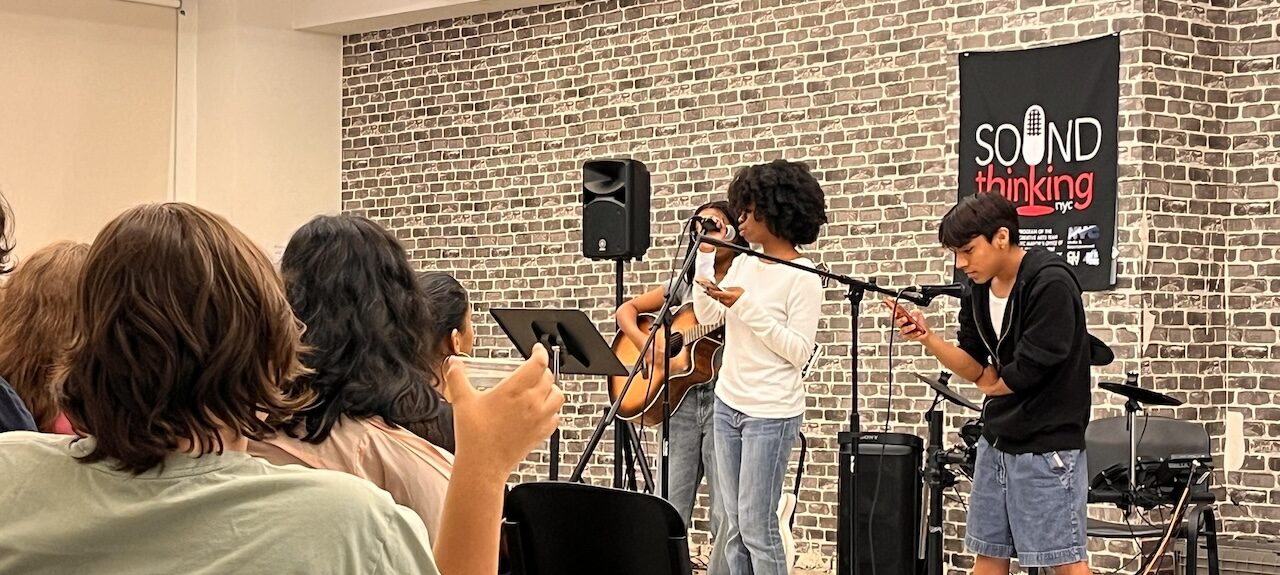Arts & Entertainment Business
Bridging music industry’s gender gap
By Michelle Yang
Amina Walker has sung for as long as she can remember: at home, in the car, in her bedroom, on city streets. But when she’s on stage, she gets butterflies in her stomach.
And when it’s her turn at the mic during Sound Thinking’s weekly jam sessions, she puts herself out there, knowing she is practicing to someday perform at larger venues. “I kind of have to remind myself that like you’d like this is something that you want to do,” said the 17-year-old, who dreams of being a professional singer-songwriter. “And if you want to do this in your future, you’re going to have to, for lack of better words, get over it.”
Women accounted for 6.5% of producers and 19.5% of songwriters in 2023, according to a 2024 report from the USC Annenberg Inclusion Initiative sponsored by Spotify. In 2012, the respective figures were 2.4% and 11%. To address that gender gap, the New York City Mayor’s Office of Media, CUNY’s Creative Arts Team and non-profit New York is Music launched Sound Thinking. Now, 85% of students at Sound Thinking are women, according to its presentation deck.
The day she talked about performing on stage, Walker was 10 days into Sound Thinking’s four-week-long free summer camp. From 10 a.m. to 12 p.m., she creates short tracks to familiarize herself with the industry-standard music production software ProTools. From 1 p.m to 3 p.m., she immerses herself in interactive lessons on being confident and networking with music industry professionals.
In two weeks, she and her peers will record their songs in a real recording studio at the Fierstein Graduate School of Cinema.
Outside of its summer program, Sound Thinking, since 2019, has offered paid internships and, since 2020, mentorship programs that pay students $1,200. Students go on tours and attend events at music powerhouses across the city, including the National Jazz Museum, Audiomack and Anti-Social Camp.
All of those activities inspired Victoria Yang, a 2021 Sound Thinking participant, to major in music technology at NYU. The program introduced her to a plethora of possible careers, including film scoring, audio engineering and marketing.
“Before that, I was, like, it’s like a one in a million chance that you’re going to actually become successful in the music industry,” the rising sophomore said. “But if I went to pursue music, I could get a career. I’m not going to end up, like, on the side of the road.”
Phoebe Siklas went to Sound Thinking’s summer program in 2023 and now, as an intern, helps manage its social media. She appreciates the connections she made with others over their shared passion for music: “Everyone’s just so supportive. I think that’s the main thing.”
While closing the gender disparity remains a priority for Sound Thinking, in 2019, its administrators opened the program to applicants of all genders. “This is all very important work,” said program director Jennifer Gil. “But what are we doing if we’re just talking to women? Are we affecting the world in the way we should be? If we’re not having conversations with everyone?”
Around 80% of its students don’t identify as white. Promoting racial and ethnic diversity is also a program aim, said 33-year-old Gil, who grew up on the Lower East Side in a family of immigrants from the Dominican Republic. Professionals in that community, who could serve as role models to young people, tended to be white.
“I always wish I had someone like me in the space–to be someone that I felt like I needed growing up,” said Gil, who, at 16, started mentoring kids at her church. “New York City needs adults in spaces to empower young people that aren’t just saying cliche things, but telling you real-life things that people wouldn’t necessarily have told me.”
Music Programs Bridge The Gender Gap in the Industry
More women are participating in jobs across the music industry according to USC Annenberg’s Inclusion Initiative’s report sponsored by Spotify in January 2024. However, they still make up a fraction of the total people in the industry compared to men.
The study analyzed 1,200 songs’ artists, songwriters and producers on the Billboard Hot 100 from 2012 to 2023. It also looked at six major Grammy categories over 2013 to 2024.
The reason why more women are in these spaces is because of the programs created to bridge the gender disparity in music, according to Dr. Stacy Smith, the study’s lead author and Associate Professor of Communications at USC Annenberg.
Sound Thinking is one of these projects. “When we started the program, it was super low. It was so low. It was scary low,” said Jennifer Gil, the director of the New York City-based program that was founded in 2018. Then, only 17.1% of artists and 2.3% of producers were women.
In 2023, 6.5% of producers, 35% of artists, and 19.5% of songwriters are women. These percentages are all-time highs since 2012: then, 2.4% of producers, 22.7% of artists and 11% of songwriters were women.
“It could be better. And it’s it’s actually kind of sad that we’re so surprised that it jumped by 3%,” Gil said, referring to how the percentage of women producers increased from 3.5% in 2022 to 6.5% in 2023.
USC Annenberg’s Inclusion Initiative is the world’s leading project to research diversity in entertainment. Their study is the seventh of its annual reports on women in he music industry.


